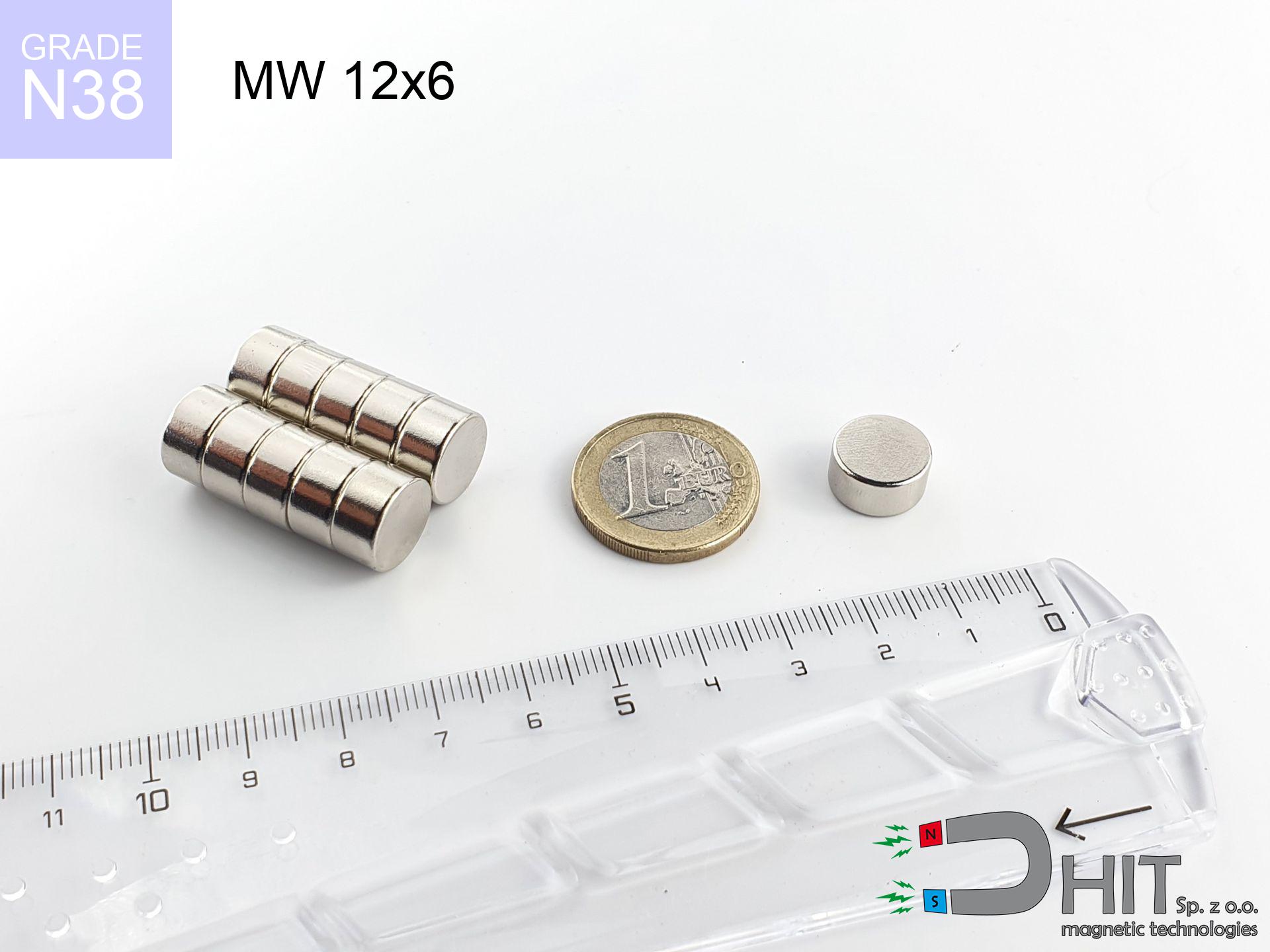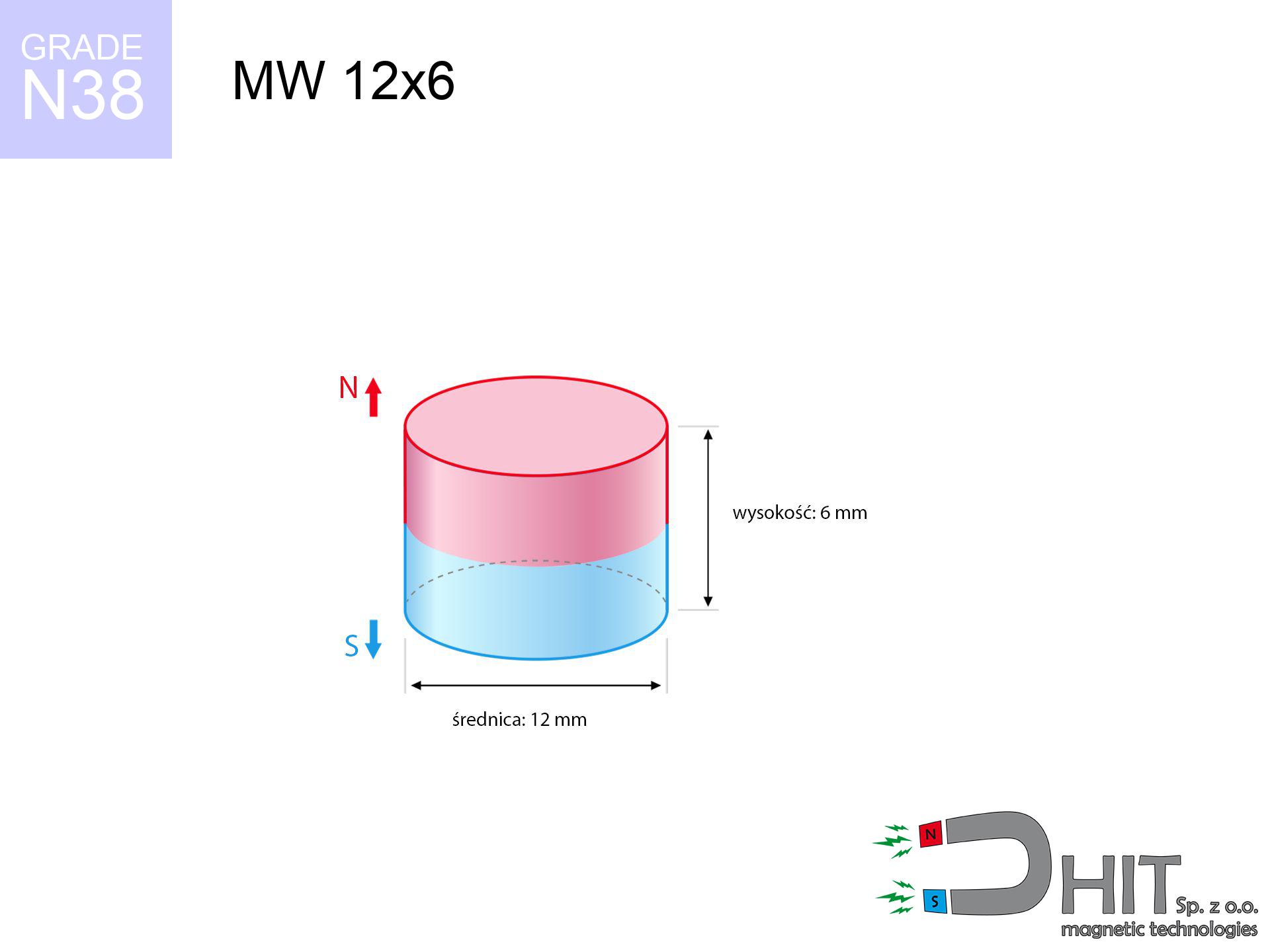MW 12x6 / N38 - cylindrical magnet
cylindrical magnet
Catalog no 010021
GTIN/EAN: 5906301810209
Diameter Ø
12 mm [±0,1 mm]
Height
6 mm [±0,1 mm]
Weight
5.09 g
Magnetization Direction
↑ axial
Load capacity
4.60 kg / 45.09 N
Magnetic Induction
437.99 mT / 4380 Gs
Coating
[NiCuNi] Nickel
1.882 ZŁ with VAT / pcs + price for transport
1.530 ZŁ net + 23% VAT / pcs
bulk discounts:
Need more?
Call us now
+48 888 99 98 98
alternatively contact us through
request form
the contact form page.
Force and structure of a neodymium magnet can be reviewed using our
force calculator.
Same-day shipping for orders placed before 14:00.
Technical of the product - MW 12x6 / N38 - cylindrical magnet
Specification / characteristics - MW 12x6 / N38 - cylindrical magnet
| properties | values |
|---|---|
| Cat. no. | 010021 |
| GTIN/EAN | 5906301810209 |
| Production/Distribution | Dhit sp. z o.o. |
| Country of origin | Poland / China / Germany |
| Customs code | 85059029 |
| Diameter Ø | 12 mm [±0,1 mm] |
| Height | 6 mm [±0,1 mm] |
| Weight | 5.09 g |
| Magnetization Direction | ↑ axial |
| Load capacity ~ ? | 4.60 kg / 45.09 N |
| Magnetic Induction ~ ? | 437.99 mT / 4380 Gs |
| Coating | [NiCuNi] Nickel |
| Manufacturing Tolerance | ±0.1 mm |
Magnetic properties of material N38
| properties | values | units |
|---|---|---|
| remenance Br [min. - max.] ? | 12.2-12.6 | kGs |
| remenance Br [min. - max.] ? | 1220-1260 | mT |
| coercivity bHc ? | 10.8-11.5 | kOe |
| coercivity bHc ? | 860-915 | kA/m |
| actual internal force iHc | ≥ 12 | kOe |
| actual internal force iHc | ≥ 955 | kA/m |
| energy density [min. - max.] ? | 36-38 | BH max MGOe |
| energy density [min. - max.] ? | 287-303 | BH max KJ/m |
| max. temperature ? | ≤ 80 | °C |
Physical properties of sintered neodymium magnets Nd2Fe14B at 20°C
| properties | values | units |
|---|---|---|
| Vickers hardness | ≥550 | Hv |
| Density | ≥7.4 | g/cm3 |
| Curie Temperature TC | 312 - 380 | °C |
| Curie Temperature TF | 593 - 716 | °F |
| Specific resistance | 150 | μΩ⋅cm |
| Bending strength | 250 | MPa |
| Compressive strength | 1000~1100 | MPa |
| Thermal expansion parallel (∥) to orientation (M) | (3-4) x 10-6 | °C-1 |
| Thermal expansion perpendicular (⊥) to orientation (M) | -(1-3) x 10-6 | °C-1 |
| Young's modulus | 1.7 x 104 | kg/mm² |
Physical simulation of the assembly - report
Presented information represent the outcome of a mathematical simulation. Results were calculated on algorithms for the material Nd2Fe14B. Real-world parameters might slightly deviate from the simulation results. Treat these data as a preliminary roadmap during assembly planning.
Table 1: Static pull force (pull vs distance) - interaction chart
MW 12x6 / N38
| Distance (mm) | Induction (Gauss) / mT | Pull Force (kg/lbs/g/N) | Risk Status |
|---|---|---|---|
| 0 mm |
4377 Gs
437.7 mT
|
4.60 kg / 10.14 lbs
4600.0 g / 45.1 N
|
warning |
| 1 mm |
3688 Gs
368.8 mT
|
3.27 kg / 7.20 lbs
3265.4 g / 32.0 N
|
warning |
| 2 mm |
2999 Gs
299.9 mT
|
2.16 kg / 4.76 lbs
2159.7 g / 21.2 N
|
warning |
| 3 mm |
2386 Gs
238.6 mT
|
1.37 kg / 3.01 lbs
1366.7 g / 13.4 N
|
safe |
| 5 mm |
1474 Gs
147.4 mT
|
0.52 kg / 1.15 lbs
521.4 g / 5.1 N
|
safe |
| 10 mm |
489 Gs
48.9 mT
|
0.06 kg / 0.13 lbs
57.4 g / 0.6 N
|
safe |
| 15 mm |
205 Gs
20.5 mT
|
0.01 kg / 0.02 lbs
10.1 g / 0.1 N
|
safe |
| 20 mm |
103 Gs
10.3 mT
|
0.00 kg / 0.01 lbs
2.5 g / 0.0 N
|
safe |
| 30 mm |
36 Gs
3.6 mT
|
0.00 kg / 0.00 lbs
0.3 g / 0.0 N
|
safe |
| 50 mm |
9 Gs
0.9 mT
|
0.00 kg / 0.00 lbs
0.0 g / 0.0 N
|
safe |
Table 2: Shear load (vertical surface)
MW 12x6 / N38
| Distance (mm) | Friction coefficient | Pull Force (kg/lbs/g/N) |
|---|---|---|
| 0 mm | Stal (~0.2) |
0.92 kg / 2.03 lbs
920.0 g / 9.0 N
|
| 1 mm | Stal (~0.2) |
0.65 kg / 1.44 lbs
654.0 g / 6.4 N
|
| 2 mm | Stal (~0.2) |
0.43 kg / 0.95 lbs
432.0 g / 4.2 N
|
| 3 mm | Stal (~0.2) |
0.27 kg / 0.60 lbs
274.0 g / 2.7 N
|
| 5 mm | Stal (~0.2) |
0.10 kg / 0.23 lbs
104.0 g / 1.0 N
|
| 10 mm | Stal (~0.2) |
0.01 kg / 0.03 lbs
12.0 g / 0.1 N
|
| 15 mm | Stal (~0.2) |
0.00 kg / 0.00 lbs
2.0 g / 0.0 N
|
| 20 mm | Stal (~0.2) |
0.00 kg / 0.00 lbs
0.0 g / 0.0 N
|
| 30 mm | Stal (~0.2) |
0.00 kg / 0.00 lbs
0.0 g / 0.0 N
|
| 50 mm | Stal (~0.2) |
0.00 kg / 0.00 lbs
0.0 g / 0.0 N
|
Table 3: Wall mounting (sliding) - behavior on slippery surfaces
MW 12x6 / N38
| Surface type | Friction coefficient / % Mocy | Max load (kg/lbs/g/N) |
|---|---|---|
| Raw steel |
µ = 0.3
30% Nominalnej Siły
|
1.38 kg / 3.04 lbs
1380.0 g / 13.5 N
|
| Painted steel (standard) |
µ = 0.2
20% Nominalnej Siły
|
0.92 kg / 2.03 lbs
920.0 g / 9.0 N
|
| Oily/slippery steel |
µ = 0.1
10% Nominalnej Siły
|
0.46 kg / 1.01 lbs
460.0 g / 4.5 N
|
| Magnet with anti-slip rubber |
µ = 0.5
50% Nominalnej Siły
|
2.30 kg / 5.07 lbs
2300.0 g / 22.6 N
|
Table 4: Material efficiency (substrate influence) - power losses
MW 12x6 / N38
| Steel thickness (mm) | % power | Real pull force (kg/lbs/g/N) |
|---|---|---|
| 0.5 mm |
|
0.46 kg / 1.01 lbs
460.0 g / 4.5 N
|
| 1 mm |
|
1.15 kg / 2.54 lbs
1150.0 g / 11.3 N
|
| 2 mm |
|
2.30 kg / 5.07 lbs
2300.0 g / 22.6 N
|
| 3 mm |
|
3.45 kg / 7.61 lbs
3450.0 g / 33.8 N
|
| 5 mm |
|
4.60 kg / 10.14 lbs
4600.0 g / 45.1 N
|
| 10 mm |
|
4.60 kg / 10.14 lbs
4600.0 g / 45.1 N
|
| 11 mm |
|
4.60 kg / 10.14 lbs
4600.0 g / 45.1 N
|
| 12 mm |
|
4.60 kg / 10.14 lbs
4600.0 g / 45.1 N
|
Table 5: Thermal resistance (material behavior) - thermal limit
MW 12x6 / N38
| Ambient temp. (°C) | Power loss | Remaining pull (kg/lbs/g/N) | Status |
|---|---|---|---|
| 20 °C | 0.0% |
4.60 kg / 10.14 lbs
4600.0 g / 45.1 N
|
OK |
| 40 °C | -2.2% |
4.50 kg / 9.92 lbs
4498.8 g / 44.1 N
|
OK |
| 60 °C | -4.4% |
4.40 kg / 9.70 lbs
4397.6 g / 43.1 N
|
|
| 80 °C | -6.6% |
4.30 kg / 9.47 lbs
4296.4 g / 42.1 N
|
|
| 100 °C | -28.8% |
3.28 kg / 7.22 lbs
3275.2 g / 32.1 N
|
Table 6: Two magnets (repulsion) - field range
MW 12x6 / N38
| Gap (mm) | Attraction (kg/lbs) (N-S) | Shear Strength (kg/lbs/g/N) | Repulsion (kg/lbs) (N-N) |
|---|---|---|---|
| 0 mm |
13.36 kg / 29.45 lbs
5 536 Gs
|
2.00 kg / 4.42 lbs
2004 g / 19.7 N
|
N/A |
| 1 mm |
11.39 kg / 25.10 lbs
8 082 Gs
|
1.71 kg / 3.77 lbs
1708 g / 16.8 N
|
10.25 kg / 22.59 lbs
~0 Gs
|
| 2 mm |
9.48 kg / 20.91 lbs
7 376 Gs
|
1.42 kg / 3.14 lbs
1423 g / 14.0 N
|
8.54 kg / 18.82 lbs
~0 Gs
|
| 3 mm |
7.77 kg / 17.12 lbs
6 675 Gs
|
1.17 kg / 2.57 lbs
1165 g / 11.4 N
|
6.99 kg / 15.41 lbs
~0 Gs
|
| 5 mm |
5.01 kg / 11.05 lbs
5 361 Gs
|
0.75 kg / 1.66 lbs
752 g / 7.4 N
|
4.51 kg / 9.94 lbs
~0 Gs
|
| 10 mm |
1.51 kg / 3.34 lbs
2 948 Gs
|
0.23 kg / 0.50 lbs
227 g / 2.2 N
|
1.36 kg / 3.01 lbs
~0 Gs
|
| 20 mm |
0.17 kg / 0.37 lbs
978 Gs
|
0.02 kg / 0.06 lbs
25 g / 0.2 N
|
0.15 kg / 0.33 lbs
~0 Gs
|
| 50 mm |
0.00 kg / 0.01 lbs
116 Gs
|
0.00 kg / 0.00 lbs
0 g / 0.0 N
|
0.00 kg / 0.00 lbs
~0 Gs
|
| 60 mm |
0.00 kg / 0.00 lbs
72 Gs
|
0.00 kg / 0.00 lbs
0 g / 0.0 N
|
0.00 kg / 0.00 lbs
~0 Gs
|
| 70 mm |
0.00 kg / 0.00 lbs
48 Gs
|
0.00 kg / 0.00 lbs
0 g / 0.0 N
|
0.00 kg / 0.00 lbs
~0 Gs
|
| 80 mm |
0.00 kg / 0.00 lbs
33 Gs
|
0.00 kg / 0.00 lbs
0 g / 0.0 N
|
0.00 kg / 0.00 lbs
~0 Gs
|
| 90 mm |
0.00 kg / 0.00 lbs
24 Gs
|
0.00 kg / 0.00 lbs
0 g / 0.0 N
|
0.00 kg / 0.00 lbs
~0 Gs
|
| 100 mm |
0.00 kg / 0.00 lbs
18 Gs
|
0.00 kg / 0.00 lbs
0 g / 0.0 N
|
0.00 kg / 0.00 lbs
~0 Gs
|
Table 7: Protective zones (electronics) - precautionary measures
MW 12x6 / N38
| Object / Device | Limit (Gauss) / mT | Safe distance |
|---|---|---|
| Pacemaker | 5 Gs (0.5 mT) | 6.5 cm |
| Hearing aid | 10 Gs (1.0 mT) | 5.0 cm |
| Timepiece | 20 Gs (2.0 mT) | 4.0 cm |
| Phone / Smartphone | 40 Gs (4.0 mT) | 3.0 cm |
| Car key | 50 Gs (5.0 mT) | 3.0 cm |
| Payment card | 400 Gs (40.0 mT) | 1.5 cm |
| HDD hard drive | 600 Gs (60.0 mT) | 1.0 cm |
Table 8: Impact energy (kinetic energy) - warning
MW 12x6 / N38
| Start from (mm) | Speed (km/h) | Energy (J) | Predicted outcome |
|---|---|---|---|
| 10 mm |
30.55 km/h
(8.49 m/s)
|
0.18 J | |
| 30 mm |
52.51 km/h
(14.59 m/s)
|
0.54 J | |
| 50 mm |
67.79 km/h
(18.83 m/s)
|
0.90 J | |
| 100 mm |
95.87 km/h
(26.63 m/s)
|
1.81 J |
Table 9: Corrosion resistance
MW 12x6 / N38
| Technical parameter | Value / Description |
|---|---|
| Coating type | [NiCuNi] Nickel |
| Layer structure | Nickel - Copper - Nickel |
| Layer thickness | 10-20 µm |
| Salt spray test (SST) ? | 24 h |
| Recommended environment | Indoors only (dry) |
Table 10: Electrical data (Flux)
MW 12x6 / N38
| Parameter | Value | SI Unit / Description |
|---|---|---|
| Magnetic Flux | 5 024 Mx | 50.2 µWb |
| Pc Coefficient | 0.59 | Low (Flat) |
Table 11: Submerged application
MW 12x6 / N38
| Environment | Effective steel pull | Effect |
|---|---|---|
| Air (land) | 4.60 kg | Standard |
| Water (riverbed) |
5.27 kg
(+0.67 kg buoyancy gain)
|
+14.5% |
1. Shear force
*Warning: On a vertical surface, the magnet holds just approx. 20-30% of its max power.
2. Steel saturation
*Thin steel (e.g. 0.5mm PC case) severely limits the holding force.
3. Thermal stability
*For N38 grade, the safety limit is 80°C.
4. Demagnetization curve and operating point (B-H)
chart generated for the permeance coefficient Pc (Permeance Coefficient) = 0.59
The chart above illustrates the magnetic characteristics of the material within the second quadrant of the hysteresis loop. The solid red line represents the demagnetization curve (material potential), while the dashed blue line is the load line based on the magnet's geometry. The Pc (Permeance Coefficient), also known as the load line slope, is a dimensionless value that describes the relationship between the magnet's shape and its magnetic stability. The intersection of these two lines (the black dot) is the operating point — it determines the actual magnetic flux density generated by the magnet in this specific configuration. A higher Pc value means the magnet is more 'slender' (tall relative to its area), resulting in a higher operating point and better resistance to irreversible demagnetization caused by external fields or temperature. A value of 0.42 is relatively low (typical for flat magnets), meaning the operating point is closer to the 'knee' of the curve — caution is advised when operating at temperatures near the maximum limit to avoid strength loss.
Material specification
| iron (Fe) | 64% – 68% |
| neodymium (Nd) | 29% – 32% |
| boron (B) | 1.1% – 1.2% |
| dysprosium (Dy) | 0.5% – 2.0% |
| coating (Ni-Cu-Ni) | < 0.05% |
Environmental data
| recyclability (EoL) | 100% |
| recycled raw materials | ~10% (pre-cons) |
| carbon footprint | low / zredukowany |
| waste code (EWC) | 16 02 16 |
Other proposals
Advantages as well as disadvantages of rare earth magnets.
Benefits
- Their power is maintained, and after around 10 years it drops only by ~1% (according to research),
- They do not lose their magnetic properties even under external field action,
- A magnet with a shiny gold surface has an effective appearance,
- Magnetic induction on the working part of the magnet remains impressive,
- Through (adequate) combination of ingredients, they can achieve high thermal resistance, enabling operation at temperatures approaching 230°C and above...
- In view of the possibility of accurate shaping and customization to unique requirements, magnetic components can be manufactured in a wide range of shapes and sizes, which increases their versatility,
- Universal use in high-tech industry – they are utilized in magnetic memories, electric drive systems, advanced medical instruments, as well as modern systems.
- Compactness – despite small sizes they provide effective action, making them ideal for precision applications
Cons
- To avoid cracks upon strong impacts, we suggest using special steel housings. Such a solution protects the magnet and simultaneously increases its durability.
- When exposed to high temperature, neodymium magnets suffer a drop in force. Often, when the temperature exceeds 80°C, their power decreases (depending on the size and shape of the magnet). For those who need magnets for extreme conditions, we offer [AH] versions withstanding up to 230°C
- They rust in a humid environment - during use outdoors we suggest using waterproof magnets e.g. in rubber, plastic
- Due to limitations in realizing threads and complicated forms in magnets, we recommend using a housing - magnetic holder.
- Potential hazard to health – tiny shards of magnets are risky, when accidentally swallowed, which is particularly important in the aspect of protecting the youngest. Additionally, tiny parts of these products are able to complicate diagnosis medical after entering the body.
- High unit price – neodymium magnets have a higher price than other types of magnets (e.g. ferrite), which increases costs of application in large quantities
Lifting parameters
Maximum magnetic pulling force – what affects it?
- on a base made of mild steel, perfectly concentrating the magnetic field
- possessing a massiveness of min. 10 mm to ensure full flux closure
- with a surface perfectly flat
- under conditions of ideal adhesion (surface-to-surface)
- during detachment in a direction vertical to the plane
- at ambient temperature room level
Determinants of practical lifting force of a magnet
- Distance (betwixt the magnet and the plate), as even a very small distance (e.g. 0.5 mm) results in a decrease in force by up to 50% (this also applies to varnish, rust or dirt).
- Direction of force – highest force is reached only during pulling at a 90° angle. The force required to slide of the magnet along the surface is usually many times lower (approx. 1/5 of the lifting capacity).
- Metal thickness – the thinner the sheet, the weaker the hold. Magnetic flux penetrates through instead of converting into lifting capacity.
- Material type – ideal substrate is high-permeability steel. Cast iron may attract less.
- Surface condition – ground elements guarantee perfect abutment, which improves field saturation. Uneven metal reduce efficiency.
- Temperature – heating the magnet results in weakening of induction. It is worth remembering the maximum operating temperature for a given model.
Lifting capacity was assessed using a steel plate with a smooth surface of optimal thickness (min. 20 mm), under vertically applied force, however under parallel forces the load capacity is reduced by as much as 75%. Additionally, even a small distance between the magnet’s surface and the plate reduces the load capacity.
Precautions when working with neodymium magnets
Bone fractures
Mind your fingers. Two large magnets will join immediately with a force of massive weight, destroying anything in their path. Be careful!
Risk of cracking
Beware of splinters. Magnets can fracture upon violent connection, ejecting shards into the air. Eye protection is mandatory.
Protect data
Equipment safety: Strong magnets can ruin payment cards and sensitive devices (heart implants, medical aids, mechanical watches).
Handling guide
Be careful. Rare earth magnets act from a long distance and connect with massive power, often faster than you can react.
Nickel coating and allergies
Some people suffer from a contact allergy to nickel, which is the common plating for neodymium magnets. Prolonged contact might lead to skin redness. We strongly advise use protective gloves.
ICD Warning
For implant holders: Strong magnetic fields disrupt electronics. Maintain at least 30 cm distance or ask another person to work with the magnets.
Fire risk
Drilling and cutting of NdFeB material carries a risk of fire risk. Neodymium dust oxidizes rapidly with oxygen and is hard to extinguish.
Do not overheat magnets
Regular neodymium magnets (grade N) undergo demagnetization when the temperature exceeds 80°C. The loss of strength is permanent.
GPS Danger
GPS units and smartphones are highly susceptible to magnetic fields. Close proximity with a powerful NdFeB magnet can ruin the sensors in your phone.
Danger to the youngest
Always keep magnets out of reach of children. Ingestion danger is significant, and the effects of magnets clamping inside the body are fatal.









